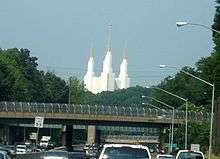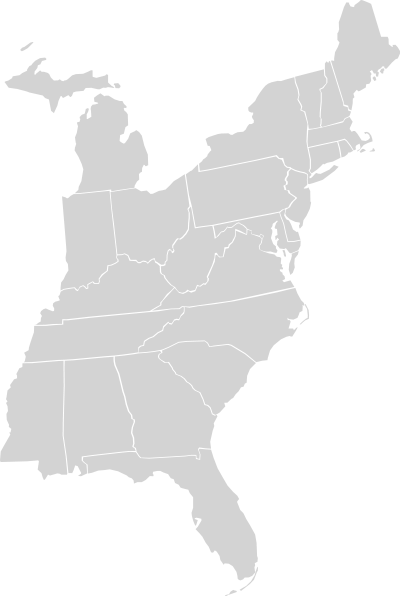Washington D.C. Temple
| Washington D.C. Temple | ||||||||||||||||||||||||||||||||||||||
|---|---|---|---|---|---|---|---|---|---|---|---|---|---|---|---|---|---|---|---|---|---|---|---|---|---|---|---|---|---|---|---|---|---|---|---|---|---|---|
 | ||||||||||||||||||||||||||||||||||||||
| Number | 16 | |||||||||||||||||||||||||||||||||||||
| Dedication | 19 November 1974 by Spencer W. Kimball | |||||||||||||||||||||||||||||||||||||
| Site | 52 acres (21 hectares) | |||||||||||||||||||||||||||||||||||||
| Floor area | 160,000 sq ft (15,000 m2) | |||||||||||||||||||||||||||||||||||||
| Height | 288 ft (88 m) | |||||||||||||||||||||||||||||||||||||
| Preceded by | Provo Utah Temple | |||||||||||||||||||||||||||||||||||||
| Followed by | São Paulo Brazil Temple | |||||||||||||||||||||||||||||||||||||
| Official website • News & images | ||||||||||||||||||||||||||||||||||||||
| ||||||||||||||||||||||||||||||||||||||
Coordinates: 39°0′50.68440″N 77°3′56.24639″W / 39.0140790000°N 77.0656239972°W The Washington D.C. Temple (formerly the Washington Temple) is the 18th constructed and 16th operating temple of The Church of Jesus Christ of Latter-day Saints (LDS Church). It is located in Kensington, Maryland, United States, just north of Washington, D.C., near the Capital Beltway. The temple was dedicated in 1974 after an open house that attracted over 750,000 people, including several international dignitaries. The temple was the first temple built by the church east of the Mississippi River since 1846, when the original Nauvoo Temple was dedicated.
Built at a cost of about $15 million, the temple is the church's tallest; its easternmost spire is 288 feet (88 m) tall. Its floor area of 160,000 square feet (15,000 m2) is the third-largest among church temples. Its design emulates the Salt Lake Temple with six spires, three on each end, and the building is encased in white Alabama marble. It also has a visitors' center. The architecture and highly visible location of the temple along the Capital Beltway has made the temple a local landmark in the Washington, D.C. Metropolitan Area.
History

Plans to build the temple were announced on November 15, 1968; a groundbreaking ceremony was held on December 7.[1] Clearing of the land started May 28, 1971. The site chosen for the temple was a 57-acre (23 ha) wooded hill purchased in 1962 just north of the Capital Beltway (Interstate 495).[2] Only 11 acres (4.5 ha) of the site was cleared to give the area a more remote feeling. It was the first LDS temple since 1846 in the United States east of the Mississippi River and remained the only LDS temple in eastern North America until the dedication of the Atlanta Georgia Temple in 1983.[3][4]
At the time of the temple's completion, its district included all Latter-day Saint members in 31 U.S. states and the District of Columbia, seven Canadian provinces, Cuba, Haiti, Puerto Rico, the Bahamas, and the Dominican Republic.[5] Original cost estimates for the temple were about $15 million. Members of the church within the temple's attendance district were asked to contribute at least $4.5 million. Eventually, local members donated around $6 million for the temple's construction.[4]

At a completion ceremony the church's First Presidency buried a metal box with historical items near a corner of the temple. During the first week of the temple open house, government officials and diplomats from around the world were taken on special tours through the temple. The open house continued for seven weeks and over 750,000 people went through the temple. The high number of people that attended the open house was attributed to the large amount of coverage that the temple and church received as the temple neared completion. Articles about the temple were printed in Time, Newsweek, and U.S. News & World Report. There was also a large press conference held that introduced the temple and church president Spencer W. Kimball. Demand for tickets to the open house was high and the tickets were gone before the first day of tours; times were extended to accommodate more people. Ten dedicatory sessions were held for the Washington D.C. Temple between November 19 and 22, 1974. Over 40,000 members attended the dedicatory services.[3][4]
During the 5.8 magnitude 2011 Virginia earthquake on August 23, 2011, the temple sustained minor damage to some parts of the exterior. The tops of four spires were knocked off and fell to the ground, as were several pieces of marble from the building's facade. No significant damage was reported to the temple's interior or to the neighboring visitor center. Repairs were made beginning in September of that year and no disruptions occurred in the temple's normal operating schedule.[6][7]
Presidents
Notable presidents of the temple include Franklin D. Richards (1983–86); David S. King (1990–93); F. Melvin Hammond (2005–08); and Earl C. Tingey (2008–11).
Architecture
The Washington D.C. Temple, designed by architect Keith W. Wilcox, was built with a modern six-spire design based on the design of the Salt Lake Temple, with the three towers to the east representing the Melchizedek priesthood, and the three towers to the west representing the Aaronic priesthood. The temple was designed to be similar in style and form to the Salt Lake Temple so that it would be easily recognized as a temple of the LDS Church.[8] The central eastern tower reaches a height of 288 feet (88 m), the tallest of any LDS Church temple. The temple has a total floor area of 160,000 square feet (15,000 m2), making it the third-largest church temple. The temple includes six ordinance rooms and fourteen sealing rooms. The Washington D.C. Temple's angel Moroni statue, which sits atop the tallest tower, is 18 feet (5.5 m) tall and weighs 2 tons.[3][4] The outer walls are covered in white Alabama marble and the spires are coated in 24-carat gold.[8] There are two large stained glass windows on the eastern and western-most spires. Although there appear to be no other windows, the marble was shaved to 0.625 inches (1.59 cm) thick over window openings, thin enough to be translucent.[9]
Location

The temple is located in suburban Kensington, Maryland, north of Washington, D.C. It is accessible mainly from the Capital Beltway (Interstate 495) exit 33, but also via the Red Line of the Washington Metro through a limited free shuttle service to and from the Forest Glen station.[10] The look and white color of the Washington D.C. Temple, coupled with its location near the Capital Beltway has made it a local landmark.[3][11] D.C.-area traffic reports often refer to the "Mormon temple" or "the temple".[12]
Sometime after the temple was constructed, an unknown person painted "Surrender Dorothy" on the girders of a railroad bridge that crosses the Beltway; to drivers approaching the temple from the east, the words appeared like a caption under the building.[13] The Maryland State Police removed the message, which has been repainted from time to time.[13][14] LDS newsletters have cited the graffiti as an example of misconceptions about their religion, although local Mormons generally find the re-appearing inscription amusing rather than offensive.[14][15]
Festival of Lights

Since 1978 the temple has annually hosted the Festival of Lights at the visitors' center, officially running from December 2 to January 1. The event attracts thousands of visitors who come to view millions of lights on the temple grounds. The festival features live performances by the Mormon Choir of Washington, D.C.; a public lighting ceremony; a narrated outdoor nativity scene; and nightly performances from various regional artists and musicians.[16] Each year, a different ambassador to the United States is invited as a guest speaker at the festival's opening lighting ceremony. For example, in 2011, J. W. "Bill" Marriott, Jr. and his wife, Donna, hosted Brazilian Ambassador to the United States Mauro Vieira, with L. Tom Perry of the Quorum of the Twelve Apostles presiding.[17]
See also
- List of temples of The Church of Jesus Christ of Latter-day Saints
- List of temples of The Church of Jesus Christ of Latter-day Saints by geographic region
- Comparison of temples of The Church of Jesus Christ of Latter-day Saints
- Temple architecture (Latter-day Saints)
Notes and references
- ↑ "Washington DC Info". lds.org. LDS Church. 2011. Retrieved October 8, 2012.
- ↑ "Temples of The Church of Jesus Christ of Latter-day Saints". Ensign. LDS Church. August 1974. Retrieved October 8, 2012.
- 1 2 3 4 Satterfield, Rick (2011). "Washington D.C. Temple". LDSChurchTemples.com. Retrieved June 26, 2011.
- 1 2 3 4 "Washington DC Mormon Temple". mormontemples.com. June 11, 2008. Retrieved October 8, 2012.
- ↑ "The Washington Temple District". Ensign. LDS Church. August 1974. Retrieved October 8, 2012.
- ↑ "East Coast quake damages people's nerves and temple spires". KSL-TV. August 23, 2011. Retrieved October 8, 2012.
- ↑ Ruoff, Alex (September 8, 2011). "Mormon temple in Kensington to undergo repairs after earthquake". Gazette.net. Retrieved October 8, 2012.
- 1 2 "To Build a Temple". Ensign. LDS Church. August 1974. Retrieved October 8, 2012.
- ↑ England, Kathy (October 1977). "The Washington D.C. Temple". Ensign. LDS Church. Retrieved October 8, 2012.
- ↑ "TempleShuttle: Go". TempleShuttle.org. 2011. Retrieved August 18, 2011.
- ↑ Saffir, Barbara J. (November 26, 2006). "Get Thrown for a Loop". In the news. University of Maryland Observatory. p. M08. Retrieved October 8, 2012.
- ↑ "The Washington D.C. Temple Photographic Essay". Meridian Magazine. Archived from the original on June 22, 2003. Retrieved October 8, 2012.
- 1 2 John Kelly, "'Surrender Dorothy' painted on a Beltway overpass — what’s the story?", Washington Post, June 24, 2011.
- 1 2 Larsen, Kent (December 8, 2001). "In View of Temple, Graffiti Again Seeks Dorothy's Surrender". MormonsToday.com. Retrieved October 12, 2012.
- ↑ Painter, Donita; Pichaske, Pete (November 8, 1999). "Landmark to most, temple is sanctuary for area's Mormons". The Montgomery County Journal. p. A5. Archived from the original on March 3, 2000. Retrieved October 8, 2012.
- ↑ "Washington D.C. Temple Festival of Lights". lds.org. LDS Church. Retrieved October 8, 2012.
- ↑ Johnson, Page (December 6, 2011). "Festival of Lights opens for holiday season at Washington D.C. Temple". Church News. Retrieved October 8, 2012.
External links
| Wikimedia Commons has media related to Washington D.C. Temple. |
- Official Washington D.C. Temple page
- Washington D.C. Temple page
- Three Stories About the Mormon Temple
- Official LDS Washington D.C. Temple Visitors' Center page
- Festival of Lights
- Washington D.C. Temple, 9900 Stoneybrook Drive, Kensington, Montgomery, MD at the Historic American Buildings Survey (HABS)
